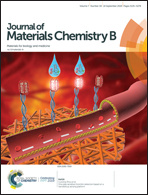Bioinspired enamel-like oriented minerals on general surfaces: towards improved mechanical properties†
Abstract
As the hardest tissue in human body, enamel has attracted significant research interest in recent years. It has been acknowledged that the highly oriented arrangement of hydroxyapatite (HAp) crystallites of the enamel plays a crucial role owing to its excellent mechanical properties. So far, the preparation of enamel-like HAp crystallites on general substrates using mild conditions remains a challenge. Here, inspired by natural enamel, we developed a biomimetic, anodic alumina oxide (AAO)-assisted, double-layered gel system to fabricate well-oriented HAp crystals on universal surfaces. The one-directional ion flow was elaborately modulated for mineralization based on the synergistic effect of the double-layered gel and the AAO membrane, leading to highly oriented HAp crystallites. In addition, the introduction of polydopamine as a nucleating agent makes this method applicable for a wide range of substrates. The as-prepared minerals show a well-aligned enamel-like structure, exhibiting an elastic modulus of 52 GPa and nanohardness of 0.73 GPa, which are close to those of natural enamel. We envision that the strategy has potential applications for tooth repair and will provide guidelines for the mineralization of other inorganic minerals.



 Please wait while we load your content...
Please wait while we load your content...